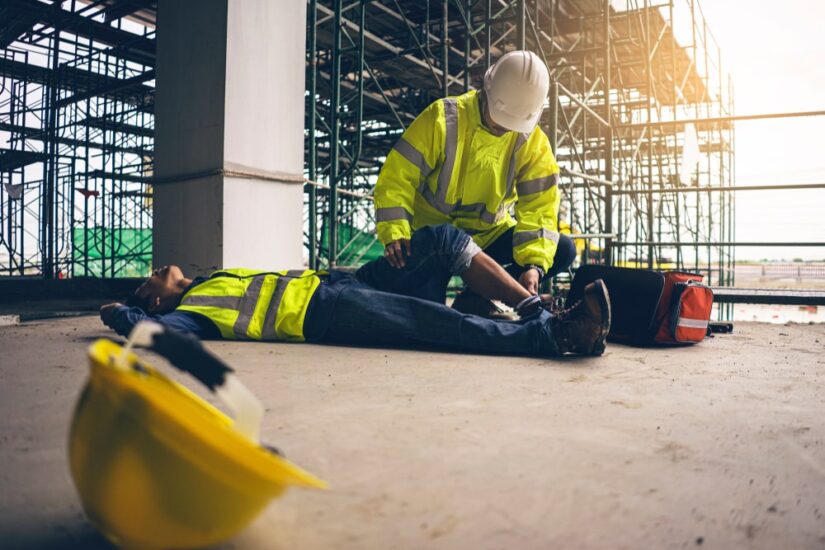
According to the California Department of Industrial Relations, recent data shows that the second highest number of fatalities that occurred between 2013 and 2017 were in the construction industry. The study showed that accidents on construction sites accounted for almost 20% of all work-related deaths. Even though the Occupational Safety and Health Administration (OSHA) has strict health and safety requirements that employers must comply with, construction accidents can result in fatalities.
If you or a loved one has suffered an injury in a construction accident, contact one of our construction accident lawyers at Maho Prentice, LLP, for a free consultation.

Slipping, Tripping, and Fall Hazards
In the study mentioned above, 32 construction worker fatalities occurred due to slips, trips, and falls in 69 of the cases reported.
These types of accidents may be caused by:
- Elevated work surfaces in areas that are missing toeboards and guard rails.
- Stairways missing treads or rails.
- Uneven floors or floors with depressions and shallow holes.
- Equipment, electrical cords, and boxes left in walkways and aisles.
- Stairways and floors that are slippery from water, grease, and other oily substances.
Unsafe Equipment
When equipment is not set up correctly or is not maintained properly, it can be deadly for construction workers. Common items used on a construction site can lead to a fatal accident when not used correctly.
The following are some safety precautions recommended by OSHA:
Scaffolding Safety
- Secure footing should be used for the placement of scaffolds.
- Scaffolding should never be altered.
- Damaged parts require replacement upon discovery.
- When scaffolding is being used by workers, it should not be moved.
- If the platform is covered with ice, snow, or other slick substances, employees should not use the scaffolding
- Never use boxes, ladders, or makeshift platforms for raising the scaffold working height
- Employees should not use scaffolding in high winds or inclement weather.
- Maximum weight requirements should always be followed on scaffold platforms.
Crane Safety
- Crane platforms and walkways should have anti-skid surfaces.
- Maximum load requirements must be followed.
- Only trained and qualified workers can operate crane machinery.
- Areas accessible to the crane swing radius must be barricaded from employee access.
- Rigging equipment and crane machinery should be inspected prior to use and only used when in good working condition.
- Operators must use and understand the load chart on cranes.
- Cranes must not operate if electrical power lines are within 10 feet.
Forklift Safety
- Designated areas should be used for forklift battery charging and these areas should not permit smoking.
- All loads should be safely arranged in the forklift to properly fit the truck capacity recommendation.
- Unsafe or defective forklifts should immediately be removed from service.
- Workers should be protected from falling objects through the use of overhead guards.
- Daily inspection of forklifts for tires, steering, forks, and brakes should be made.
- Forklift use is only permitted for adults 18 years of age and older.
- Forklifts should only be operated by qualified and trained employees.
Lack of Electrical Power Line Protection
Construction areas may be in the vicinity of power lines and when safety standards recommended by OSHA are not followed, fatal injuries can occur to construction workers. The following safety standards should be followed near electrical power lines:
- Electrical tools must be checked for damage and immediately replaced if defects are found.
- Extension cords should have grounding prongs.
- Worn electrical cords that are damaged or frayed should be replaced.
- Never work on live electrical circuits until electrical grounds are attached and all power is shut off.
Lack of Trench Area Protection
Excavation and trench accidents are common for construction workers. Unfortunately, many of these accidents lead to fatal injuries. From collapses and cave-ins to exposure to dust, vapors, and hazardous gasses, trench workers need protection using the following precautions:
- Trenches should be carefully inspected for safety prior to entering.
- The trench should have a safe way of entering and exiting by all employees.
- Protective systems should be in place to prevent cave-ins, including benching or sloping trench walls, trench boxes for shielding trench walls, or shoring trench walls with supports.
- Underground utilities should be identified and located prior to digging.
- Heavy equipment should be kept at a safe distance from trench edges.
Construction Accident Injury Attorneys
If you suffered injuries on a construction site that could have been prevented, the experienced construction accident attorneys from Maho Prentice, LLP, can help. Contact us today via our online form to discuss your case.